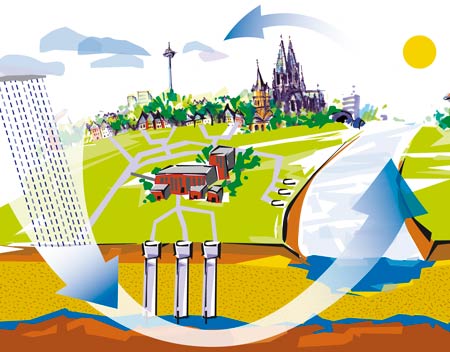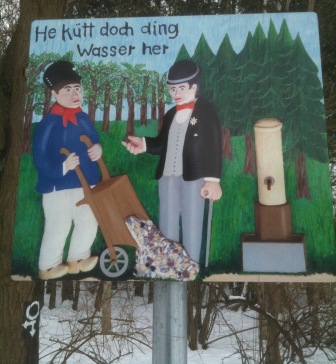Kölner Grundwasser EarthCache
-
Difficulty:
-

-
Terrain:
-

Size:  (other)
(other)
Please note Use of geocaching.com services is subject to the terms and conditions
in our disclaimer.
Kölner Grundwasser und Wasserwerk Weiler
Das Wasser, das wir täglich brauchen, ist eine Leihgabe der Natur. Das auf der Erde verfügbare Wasser befindet sich in einem immerwährenden Kreislauf. Als Wasserdampf steigt es zum Himmel, wo es in Form von Wolken von der Luft getragen wird. Als Niederschlag kehrt es zur Erde zurück und setzt seine Reise in Richtung Meer fort. Ein Teil des Niederschlags versickert im Boden und wird dabei gefiltert und durch Mikroorganismen auf natürliche Weise gereinigt, während es über mehrere Wochen verschiedene Bodenschichten passiert.
Grundwasser gilt als besonders sauber und deshalb als "gutes Rohwasser". Die Bodenschichten wirken wie ein natürlicher Filter. In der Kölner Bucht bestehen diese Schichten aus Rheinkies (im Allgemeinen um einen natürlich abgelagerten oder künstlich geschütteten Körper aus in Fließgewässern rundgeschliffenen kleinen Steinen, umgangssprachlich Kieselsteinen), Sand (Sand ist ein natürlich vorkommendes, unverfestigtes Sedimentgestein, das sich aus einzelnen Sandkörnern mit einer Korngröße von 0,063 bis 2 mm zusammensetzt), Löss (Mineralogisch besteht Löss zum größten Teil (50 % – 80 %) aus Quarzkörnern mit 8 % – 20 % kalkigen Bruchstücken. Beimengungen von Eisenhydroxiden färben Löss gelblich bis gelblich-rot.) und weitere poröse Gesteinsschichten.
Die Wasserwerke entleihen sich aus diesem Kreislauf das Wasser, das nach dem Gebrauch in Haushalt und Gewerbe von Kläranlagen gereinigt dem natürlichen Wasserkreislauf zurückgegeben wird.

Hier sehen Sie, wie ein Wasserwerk in den Wasserkreislauf integriert ist. Ein mächtiger Grundwasserstrom fließt langsam unterirdisch auf den Rhein zu und damit auch auf die Brunnen des Wasserwerkes. Mit Hilfe der Brunnen fördern wir das Wasser aus dem Untergrund nach oben.
Der Grundwasserstrom wird von den in unserer Region sehr häufigen und ergiebigen Niederschlägen gespeist. Das Wasserwerk Weiler fördert nur einen Teil der Menge des Grundwassers, die sich jährlich erneuert. Zusätzlich nutzt sie Uferfiltrat zur Anreicherung des Grundwassers. Selbst in den seltenen sehr trockenen Zeiten kommt es daher nicht zu Engpässen bei der Trinkwasserversorgung.

Analyse des Grundwassers im Wasserwerke Weiler, Stand 2010
Gesamthärte 3,35 ± 0,16 mmol/l (hart)
pH-Wert 7,23 ± 0,05
Calcium 109,9 ± 5,0 mg/l
Magnesium 14,6 ± 0,8 mg/l
Natrium 37,2 ± 2,1 mg/l
Nitrat 22,5 ± 1,5 mg/l
Fluorid 0,12 mg/l
Sulfat 83,7 ± 7,2 mg/l
Phosphat gesamt < 0,05 mg/l
(Quelle: RheinEnergie Köln)
Um diesen Earthcache zu loggen, beantworte uns bitte folgende Fragen von der kleinen Info-Tafel „Erzählstation Wasserwerk Weiler“ und den nahen Ausstellungsstücken. Hinweis: Die Antworten werden nicht durch die Baustelle behindert. Schaut Euch um …
1. Wodurch bahnt sich das Grundwasser aus der Brunnengalerie seinen Weg??
2. Die Kölner Wasserwerke sichern mit bis .... Kubikmetern pro Stunde die Versorgung der Stadt??
3. Das hier ausgestellte Schlitzbrückenfilterrohr hat einen Durchmesser von ....??
Schicke uns eine eMail über unser Profi mit deinen Antworten. Du kannst den Cache direkt loggen, falls etwas nicht stimmen sollte, werden wir uns bei Dir melden
Wie erfolgt die Logfreigabe bei einem EarthCache?
Es wäre schön, wenn Ihr an den Log ein Foto von Euch an den dortigen Pumpen und Maschinen oder der Info-Tafel beifügen würdet
short english version
The water we need every day, is on loan from the nature. Located on the ground water available in a perpetual cycle. As water vapor rises to the sky, where it is carried in the form of clouds from the air. As rain it will return to Earth and continues its journey towards the sea. Part of the precipitation seeps into the ground and is filtered and purified by this microorganism in a natural way while it happened over several weeks to a different soil layers. The water works borrow from this circuit, the water cleaned after use in household and commercial sewage treatment plants of the natural water cycle is returned.
Groundwater is a particularly clean and therefore a "good raw water. The bottom layers act as a natural filter. In the Cologne bay are these layers of Rhine gravel (generally a naturally deposited or man dumped the body from some ground in streams of pebbles, commonly gravel), sand (Sand is a naturally occurring, unconsolidated sedimentary rock, which consists of individual sand grains with a grain size 0.063 to 2 mm composed), loess (Mineralogical Loess consists largely (50% - 80%) of quartz grains with 8% -. 20% limestone fragments admixtures of iron hydroxides loess color yellow to yellowish-red) and other porous rock layers.
Here's how a water company is incorporated in the water cycle. A powerful flow of groundwater flows slowly underground on the Rhine, and thus on the wells of the waterworks. By using the fountain, we pump the water from the ground up.
The aquifer is fed by the very frequent in our region and abundant precipitation. The waterworks Weiler promotes only part of the amount of groundwater that is renewed annually. In addition, they use bank filtration for the enrichment of groundwater. Even in the rare very dry periods, it is therefore not to bottlenecks in the supply of drinking water.
Analysis of groundwater in the water works Weiler, Stand 2010
Total hardness 3.35 ± 0.16 mmol / l (hard)
pH 7.23 ± 0.05
Calcium 109.9 ± 5.0 mg / l
Magnesium 14.6 ± 0.8 mg / l
Sodium 37.2 ± 2.1 mg / l
Nitrate 22.5 ± 1.5 mg / l
Sulfate 83.7 ± 7.2 mg / l
Total phosphate <0.05 mg / l
(Source: Rhein Energie Cologne)
In order to log this earth cache, please answer the following questions from the small information board “Narrative station waterworks Weiler“ and the nearby exhibits
1. How does the groundwater find its way out of the well gallery ??
2. The Cologne waterworks secure the supply of the city with up to .... cubic meters per hour ??
3. The slotted bridge filter tube exhibited here has a diameter of .... ?
Send us an email with your answers. You can log in directly to the cache, if anything happens to agree, we will contact you
As the log release takes place at an Earth Cache?
It would be nice if you would add to the log a photo of you at the local pumps and machinery or the information panel
Additional Hints
(Decrypt)
Trtraüore qre Onhfgryyr nz Mnha tvog rf rva xyrvarf Fpuvyq